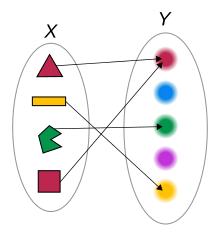Map (mathematics)

In mathematics, a map is often used as a synonym for a function,[1] but may also refer to some generalizations. Originally, this was an abbreviation of mapping, which often refers to the action of applying a function to the elements of its domain. This terminology is not completely fixed, as these terms are generally not formally defined, and can be considered to be jargon.[2][3] These terms may have originated as a generalization of the process of making a geographical map, which consists of mapping the Earth surface to a sheet of paper.[4]
Maps may either be functions or morphisms, though the terms share some overlap.[4] The term map may be used to distinguish some special types of functions, such as homomorphisms. For example, a linear map is a homomorphism of vector spaces, while the term linear function may have this meaning as well as another one.[5][6] In category theory, a map may refer to a morphism, which is a generalization of the idea of a function. In some occasions, the term transformation can also be used interchangeably.[4] There are also a few less common uses in logic and graph theory.
Maps as functions
In many branches of mathematics, the term map is used to mean a function,[7][3][8] sometimes with a specific property of particular importance to that branch. For instance, a "map" is a "continuous function" in topology, a "linear transformation" in linear algebra, etc.
Some authors, such as Serge Lang,[9] use "function" only to refer to maps in which the codomain is a set of numbers (i.e. a subset of R or C), and reserve the term mapping for more general functions.
Maps of certain kinds are the subjects of many important theories. These include homomorphisms in abstract algebra, isometries in geometry, operators in analysis and representations in group theory.[4]
In the theory of dynamical systems, a map denotes an evolution function used to create discrete dynamical systems.
A partial map is a partial function. Related terms such as domain, codomain, injective, and continuous can be applied equally to maps and functions, with the same meaning. All these usages can be applied to "maps" as general functions or as functions with special properties.
As morphisms
In category theory, "map" is often used as a synonym for "morphism" or "arrow", and thus is more general than "function".[10] For example, a morphism in a concrete category (i.e. a morphism which can be viewed as functions) carries with it the information of its domain (the source of the morphism) and its codomain (the target ). In the widely used definition of a function , is a subset of consisting of all the pairs for . In this sense, the function does not capture the information of which set is used as the codomain; only the range is determined by the function.
Other uses
In logic
In formal logic, the term map is sometimes used for a functional predicate, whereas a function is a model of such a predicate in set theory.
In graph theory

In graph theory, a map is a drawing of a graph on a surface without overlapping edges (an embedding). If the surface is a plane then a map is a planar graph, similar to a political map.[11]
In computer science
In the communities surrounding programming languages that treat functions as first-class citizens, a map is often referred to as the binary higher-order function that takes a function f and a list [v0, v1, ..., vn] as arguments and returns [f(v0), f(v1), ..., f(vn)] (where n ≥ 0).
See also
- Bijection, injection and surjection – Properties of mathematical functions
- Homeomorphism – Mapping which preserves all topological properties of a given space
- Permutation group – Group whose operation is composition of permutations
- Regular map (algebraic geometry) – Morphism of algebraic varieties
- Mapping class group – Group of isotopy classes of a topological automorphism group
- List of chaotic maps
- Apply function – Function that maps a function and its arguments to the function value
References
- ^ The words map, mapping, transformation, correspondence, and operator are often used synonymously. Halmos 1970, p. 30. Some authors use the term map with a more general meaning than function, which may be restricted to apply to numbers only.
- ^ "The Definitive Glossary of Higher Mathematical Jargon — Mapping". Math Vault. 2019-08-01. Retrieved 2019-12-06.
{{cite web}}: CS1 maint: url-status (link) - ^ a b Weisstein, Eric W. "Map". mathworld.wolfram.com. Retrieved 2019-12-06.
- ^ a b c d "Mapping | mathematics". Encyclopedia Britannica. Retrieved 2019-12-06.
- ^ Apostol, T. M. (1981). Mathematical Analysis. Addison-Wesley. p. 35. ISBN 0-201-00288-4.
- ^ Stacho, Juraj (October 31, 2007). "Function, one-to-one, onto" (PDF). cs.toronto.edu. Retrieved 2019-12-06.
{{cite web}}: CS1 maint: url-status (link) - ^ "Functions or Mapping | Learning Mapping | Function as a Special Kind of Relation". Math Only Math. Retrieved 2019-12-06.
- ^ "Mapping, Mathematical | Encyclopedia.com". www.encyclopedia.com. Retrieved 2019-12-06.
- ^ Lang, Serge (1971). Linear Algebra (2nd ed.). Addison-Wesley. p. 83. ISBN 0-201-04211-8.
- ^ Simmons, H. (2011). An Introduction to Category Theory. Cambridge University Press. p. 2. ISBN 978-1-139-50332-7.
- ^ Gross, Jonathan; Yellen, Jay (1998). Graph Theory and its applications. CRC Press. p. 294. ISBN 0-8493-3982-0.









